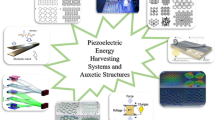Abstract
Energy harvesting is the process of attaining energy from the external sources and transforming it into usable electrical energy. An analytical model of piezoelectric energy harvester has been developed to determine the output voltage across an electrical circuit when it is forced to undergo a base excitation. This model gives an easy approach to design and investigate the behavior of piezoelectric material. Numerical simulations have been carried out to determine the effect of frequency and loading on a Lead zirconate titanate (PZT-5A) piezoelectric material. It has been observed that the output voltage from the harvester increases when loading increases whereas its resonance frequency decreases. The analytical results were found to be in good agreement with the experimental and numerical simulation results.
Similar content being viewed by others
References
M. Soliman et al., A wideband vibration-based energy harvester, Journal of Micromechanics and Microengineering, 18 (11) (2008) 115021.
K. Cook-Chennault, N. Thambi and A. Sastry, Powering MEMS portable devices—a review of non-regenerative and regenerative power supply systems with special emphasis on piezoelectric energy harvesting systems, Smart Materials and Structures, 17 (4) (2008) 043001.
D. Vasic, Y.-Y. Chen and F. Costa, Self-powered piezoelectric energy harvester for bicycle, Journal of Mechanical Science and Technology, 28 (7) (2014) 2501–2510.
A. Safari and E. K. Akdogan, Piezoelectric and acoustic materials for transducer applications, Springer Science & Business Media (2008).
W. Heywang, K. Lubitz and W. Wersing, Piezoelectricity: evolution and future of a technology, Springer Science & Business Media, 114 (2008).
K. N. Choi and H. H. Rho, Continuous energy harvesting method using piezoelectric element, 2015 IEEE 2nd International, Future Energy Electronics Conference (IFEEC) (2015).
Z. Xiao et al., Energy harvester array using piezoelectric circular diaphragm for broadband vibration, Applied Physics Letters, 104 (22) (2014) 223904.
X.-R. Chen et al., Vibration energy harvesting with a clamped piezoelectric circular diaphragm, Ceramics International, 38 (2012) S271–S274.
E. Minazara, D. Vasic and F. Costa, Piezoelectric generator harvesting bike vibrations energy to supply portable devices, Proceedings of International Conference on Renewable Energies and Power Quality (ICREPQ'08), Santander, Spain (2008).
K. Ahmed, EE462: Fundamentals of Control Systems Engineering.
A. Tabesh and L. G. Fréchette, On the concepts of electrical damping and stiffness in design of a piezoelectric bending beam energy harvester, Proc. Power MEMS 2009 (2009) 368–371.
T. Tanner and D. Inman, Combined shock and vibration isolation through the optimal control of hybrid ‘smart’mount, Proc. 73rd Shock and Vibration Symp. (Newport Beach, RI) (2002).
A. Erturk and D. J. Inman, Issues in mathematical modeling of piezoelectric energy harvesters, Smart Materials and Structures, 17 (6) (2008) 065016.
S. Adhikari, M. Friswell and D. Inman, Piezoelectric energy harvesting from broadband random vibrations, Smart Materials and Structures, 18 (11) (2009) 115005.
M. Fakhzan and A. G. Muthalif, Harvesting vibration energy using piezoelectric material: Modeling, simulation and experimental verifications, Mechatronics, 23 (1) (2013) 61–66.
N. E. Dutoit, B. L. Wardle and S.-G. Kim, Design considerations for MEMS-scale piezoelectric mechanical vibration energy harvesters, Integrated Ferroelectrics, 71 (1) (2005) 121–160.
A. Erturk and D. J. Inman, A distributed parameter electromechanical model for cantilevered piezoelectric energy harvesters, Journal of Vibration and Acoustics, 130 (4) (2008) 041002.
F. Qayyum et al., Numerical simulation of thermal fatigue behavior in a cracked disc of AISI H-11 tool steel, Engineering Failure Analysis, 62 (2016) 242–253.
Z. Anjum et al., Prediction of non-propagating fretting fatigue cracks in Ti6Al4V sheet tested under pin-in-dovetail configuration: Experimentation and numerical simulation, Materials & Design, 87 (2015) 750–758.
W. Wang et al., Application of different surrogate models on the optimization of centrifugal pump, Journal of Mechanical Science and Technology, 30 (2) (2016) 567–574.
A. Moftakhari, C. Aghanajafi and A. M. C. Ghazvin, Thermal analysis of HVAC and solar panels using genetic optimization algorithm, Journal of Mechanical Science and Technology, 30 (3) (2016) 1405–1412.
A. Saigal et al., Electrical response during indentation of a 1-3 piezoelectric ceramic-polymer composite, Journal of Applied Physics, 86 (1) (1999) 603–606.
M. N. Ghasemi-Nejhad et al., Finite element method for active vibration suppression of smart composite structures using piezoelectric materials, Journal of Thermoplastic Composite Materials, 19 (3) (2006) 309–352.
H. Allik and T. J. Hughes, Finite element method for piezoelectric vibration, International Journal for Numerical Methods in Engineering, 2 (2) (1970) 151–157.
S. W. Ibrahim and W. G. Ali, Parametric identification for piezoelectric energy harvester (2013).
A. Giannakopoulos and S. Suresh, Theory of indentation of piezoelectric materials, Acta Materialia, 47 (7) (1999) 2153–2164.
Author information
Authors and Affiliations
Corresponding author
Additional information
Recommended by Editor Chongdu Cho
Zubair Butt was born in Sialkot, Pakistan, in 1988. He received his B.Sc. degree from UET Taxila, in 2012. He received his M.Sc. degree in Mechanical Engineering from UET Taxila, in 2015. Now he is working as a Lecturer in Department of Mechanical, Mechatronics and Manufacturing Engineering, UET Lahore Faisalabad Campus, Pakistan. His research interest includes the Energy harvesting terminology and MEMS system.
Rights and permissions
About this article
Cite this article
Butt, Z., Pasha, R.A., Qayyum, F. et al. Generation of electrical energy using lead zirconate titanate (PZT-5A) piezoelectric material: Analytical, numerical and experimental verifications. J Mech Sci Technol 30, 3553–3558 (2016). https://doi.org/10.1007/s12206-016-0715-3
Received:
Revised:
Accepted:
Published:
Issue Date:
DOI: https://doi.org/10.1007/s12206-016-0715-3




